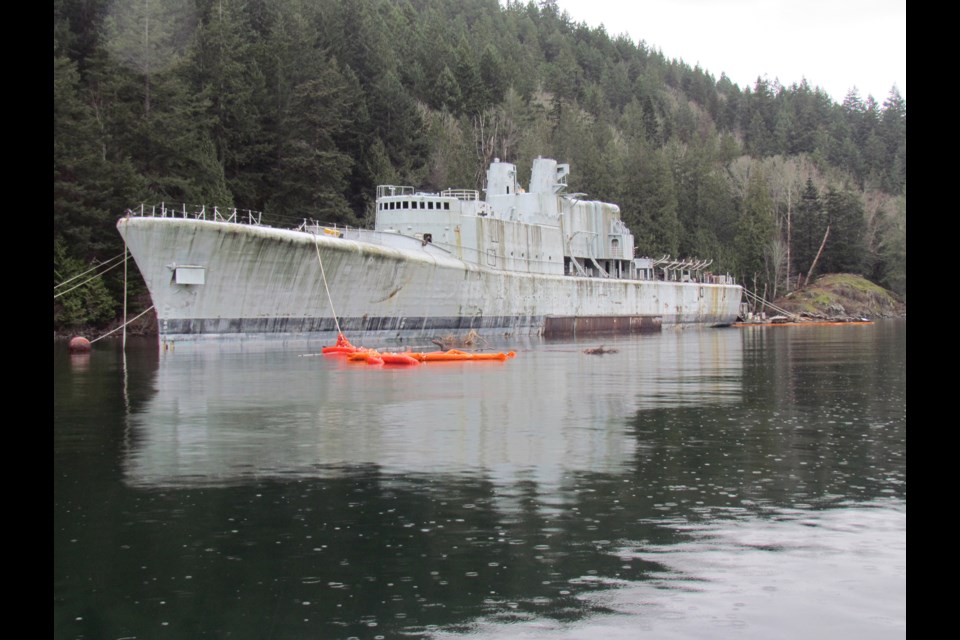In her prime, the 1960s-era HMCS Annapolis warship sailed the open seas off the eastern and western Canadian coasts for the Royal Canadian Navy.
During the late 1980s, the helicopter-carrying destroyer was the first Canadian navy ship fitted with a towed array sonar system. She was decommissioned in 1996.
Come January, after years of anticipation, a court case and plenty of controversy, the Annapolis will be sunk in Halkett Bay Marine Provincial Park, in Howe Sound, to serve her afterlife as an artificial reef.
“The good news is… all the permits are now in place, Environment Canada has done its final inspection... and they passed the inspection,” said Richard Wall of the Artificial Reef Society of British Columbia, which bought the Annapolis from the federal government in 2008.
Wall said Fisheries and Oceans Canada “is happy because we are creating habitat, not destroying habitat.”
The original plan had called for the Annapolis to be sunk in 2009.
One of the main hold-ups has been getting the ship cleaned up enough to be sunk.
The federal government “has very stringent disposal at sea regulations which we have been following, and Environment Canada would not allow us to sink until they were satisfied, which is one of the reasons the big delays happen,” Wall said.
The crash of commodity prices around the time the Annapolis project started also contributed to the long delay in preparing the ship for sinking.
“Traditionally we used the scrap to basically hire professionals to do the work in six to nine months, and having to depend on volunteers means that you have an uncertain workforce and very restricted timelines – they can only work on weekends and sometimes we get 25 people out and sometimes we can only get five people out,” Wall said.
There was also the matter of a court case that dragged on.
Wes Roots, of WR Marine Services, put a lien on the ship because he said he was owed for the Annapolis’ moorage fees and operational services. The Federal Court freed the Annapolis from the lien on Nov. 4, meaning the sinking can go ahead.
But there are many who would rather the ship not be sunk at all.
“I don’t like to see us dropping garbage into the ocean, and I don’t like to see us dropping resources into the ocean,” said John Buchanan, a Squamish environmental activist who has been watching the ongoing preparations for the sinking. “It represents a massive amount of steel. And steel being the number two polluter in the world, I just think it is the federal government’s way of getting rid of a problem.”
According to Clarke Longmuir, president of Amix Salvage & Sales Ltd. in New Westminster, it is possible to break down large ships such as the 113-metre, 2,900-ton Annapolis, but it is costly.
“Often the problem is that the value of the scrap you will yield from breaking it up won’t cover the cost of doing it,” he said. “To break up a big ship is going to cost, potentially, millions of dollars.”
But Wall said that the federal government did not shuffle the Annapolis to his not-for- profit organization.
“They didn’t just dump it on us, they actually paid for the remediation,” he said.
And Wall said rather than becoming marine garbage, the ship will be beneficial to the ocean and sea life of the area.
“There is a shortage of iron in sea water, and that is why the filter-feeders, the anemones and sponges flock to any type of metal that goes into the ocean because they need the iron to thrive.”
A rusting hull provides a good source of food for them, said Wall, the navy liaison director for the Annapolis project.
Wall served at sea on the Annapolis for a time.
He predicts based on the seven other artificial reefs the society has created, within three years close to 100 species will colonize the reef including rockfish, barnacles, shrimp, lingcod, scallops, sea cucumbers, crabs and sea stars.
Still, there are those who say the ship is a danger to the environment.
“We’ve been opposing this project for more than six years,” said Colleen Dragan of the Save Halkett Bay Campaign. Dargan worries that the ship’s paint could contain chemicals.
Wall said the exact timing of the sinking will be determined by the weather. If it is too windy, it can’t be sunk.
After an inspection, scuba divers will be free to explore it.




